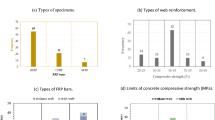Abstract
This study investigates the use of Genetic Programming (GP) to model Reinforced Concrete (RC) beam torsional strength. Experimental data of 76 rectangular RC beams from an existing database were used to develop the GP model. The following input parameters, which affect torsional strength, were selected: beam cross-sectional area, closed stirrup dimensions, stirrup spacing, closed stirrup cross-sectional area of one leg, stirrup and longitudinal reinforcement yield strength, stirrup steel ratio, longitudinal reinforcement steel ratio and concrete compressive strength. Moreover, a short review of well-known building codes in relation to the design of RC beams under pure torsion is presented. The accuracy of the codes in predicting the RC beam torsional strength was also compared with the proposed GP model using the same test data. The study concludes that the proposed GP model predicts RC beam torsional strength more accurately than building codes
Similar content being viewed by others
References
ACI Committee 318-2005 (2005). Building code requirements for structural concrete (ACI 318-05) and commentary (318R-05), American Concrete Institute, Farmington Hills.
ACI Committee 318-71 (1971). Building code requirements for structural concrete and commentary, American Concrete Institute, Detroit.
ACI Committee 318-89 (1989). Building code requirements for structural concrete and commentary, American Concrete Institute, Detroit.
ACI Committee 318-95 (1995). Building code requirements for structural concrete and commentary, American Concrete Institute, Detroit.
Ameli, M. and Ronagh, H. R. (2007). “Treatment of torsion of RC beams in current structural standards.” Asian Journal of Civil Engineering (Building and Housing), Vol. 8, No. 5, pp. 507–519.
AS3600 (2001). Concrete structures, Standarts Association of Australia.
BS8110 (1985). Structural use of concrete-Part 2, British Standards.
Canadian Standard Association (1994). Design of concrete structures: Structure design, CSA Standard, A23-3-94, Canadian Standard Association, Rexdale, Ontario.
Collins, C. D., Walsh, P. F., Archer, F. E., and Hall, A. S. (1965). Reinforced concrete beams subjected to combined torsion and shear, UNICIV Report, No. R-14, University of New South Wales.
Collins, C. P. and Mitchell, D. (1980). “Shear and torsion design of prestressed and non-prestressed concrete beams.” PCI Journal, Vol. 25, No. 5, pp. 32–100.
Collins, M. P. and Mitchell, D. (1980). “Shear and torsion design of prestressed and non-prestressed concrete beams.” PCI Journal, Vol. 25, No. 5, pp. 32–100.
Elfegren, L., Karlsson, I., and Losberg, A. (1974) “Torsion bending-shear interaction for concrete beams.” Journal of Structural Division ASCE, Vol. 100, No. ST 8, pp. 1657–1676.
European Standard (2002). Eurocode 2: Design of concrete structures, prEN, 1992-1-1, Draft for stage 49, Commission of the European Communities, European Committee for Standardization.
Fang, I. K. and Shiau, J. K. (2004). “Torsional behavior of normal and high strength concrete beams.” ACI Structural Journal, Vol. 101, No. 3, pp. 304–313.
Ferreira, C. (2001). “Gene expression programming in problem solving.” Invited tutorial of the 6th Online World Conference on Soft Computing in Industrial Applications, September, pp. 10–24.
Ferreira, C. (2001). “Gene expression programming: A new adaptive algorithm for solving problems.” Complex Systems, Vol. 13, No. 2, pp. 87–129.
Ferreira, C. (2002). Gene expression programming, Mathematical Modeling by an Artificial Intelligence (Studies in Computational Intelligence), Springer-Verlag New York, Inc., Secaucus, NJ.
Hossain, T., Mendis, P., Thiru, A., and Graham, B. (2006) “Torsional resistance of high-strength concrete beams.” In: 19th Australasian Conference on the Mechanics of Structures and Materials, 29 Nov–1 Dec 2006, Christchurch, NZ.
Hsu, T. T. C. (1968). Torsion of structural concrete-behavior of reinforced concrete rectangular members, Torsion of Structural Concrete SP-18, ACI, Farmington Hills. Mich, pp. 261–306.
Hsu T. T. C. and Mo, Y. L. (1985). “Softening of concrete in torsional members-design recommendation.” ACI Journal, Vol. 82, No. 4, pp. 443–452.
Ireland, J. C., Baeten. M., Foster. J., Lutton, E., and Ryan, C. (2002). Genetic programming, 5th European Conference, EuroGP.
Koutchoukali, N. E. and Belarbi, A. (1997). “Effect of concrete strength on the behavior of RC beams subjected to pure torsion.” American Society of Civil Engineers, Special Publication on High Strength Concrete, pp. 38–51.
Koutchoukali, N. E. and Belarbi, G. (2001). “Torsion of high strength reinforced concrete beams and minimum reinforcement requirement.” ACI Structural Journal, Vol. 98, No. 4, pp. 462–469.
Koza, J. R. (1992). Genetic programming: On the programming of computers by means of natural selection, Cambridge, MA: MIT Press.
Lessig, N. N. (1959) “Determination of carrying capacity of reinforced concrete elements with rectangular cross — section subjected to flexure with torsion.” Institute Betona i Zhelezobetona, Vol. 5, pp. 5–28.
McMullen, A. E. and Rangan, B. V. (1978). “Pure torsion in rectangular section — A reexamination.” J. Am. Concrete Inst., Vol. 75,52, pp. 511–519.
Rasmussen, L. J. and Baker, G. (1995). “Torsion in reinforced normal and high strength concrete beams part-I: An experimental test series.” ACI Structural Journal, Vol. 92, No. 1, pp. 56–62.
Rausch, E. (1929). “Design of reinforced concrete in torsion.” Technische Hochschule: Berlin, Vol. 53 (in German).
Tang, C. W. (2006). “Using radial basis function neural networks to model torsional strength of reinforced concrete beams.” Computers and Concrete, Vol. 3, No. 5, pp. 335–355.
TBC-500-2000 (2000) Requirements for design and construction of reinforced concrete structures, Turkish Standards TS-500, Ankara.
Victor, D. J. and Muthukrishnan, R. (1973). “Effect of stirrups on ultimate torque of reinforced concrete beams.” ACI Journal Proceeding, Vol. 70, No. 4, pp. 300–306.
Zang, Y. (2002). Torsion in high strength concrete rectangular beams, Master thesis, University of Nevada.
Author information
Authors and Affiliations
Corresponding author
Rights and permissions
About this article
Cite this article
Cevik, A., Arslan, M.H. & Köroğlu, M.A. Genetic-programming-based modeling of RC beam torsional strength. KSCE J Civ Eng 14, 371–384 (2010). https://doi.org/10.1007/s12205-010-0371-6
Received:
Revised:
Accepted:
Published:
Issue Date:
DOI: https://doi.org/10.1007/s12205-010-0371-6




